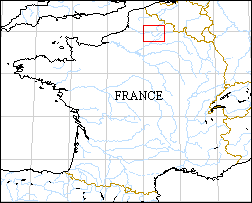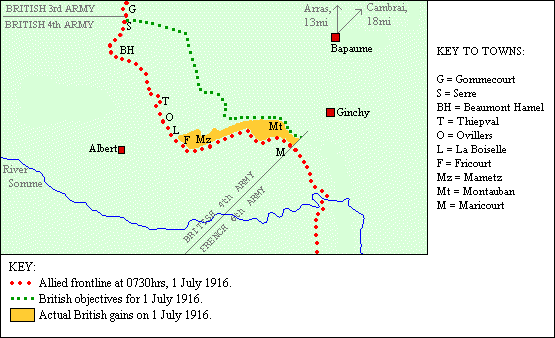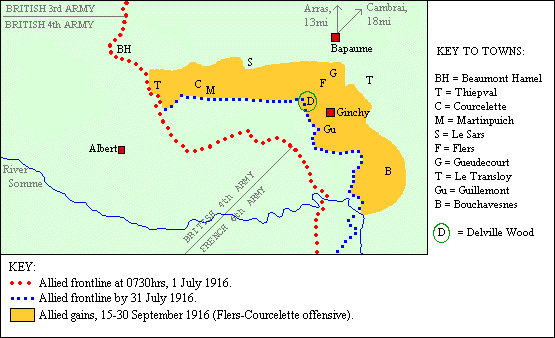1 july - 19 November 1916

The original plan agreed in December 1915 is that, at a date to be decided in the summer of 1916, forty French divisions will attack from south of the river while twenty-five British divisions attack simultaneously from the north bank. In the week before the assault, the German lines will be battered to pieces by an overwhelming artillery bombardment, enabling the infantry to cross no-man's-land and occupy the destroyed and almost undefended
highlighted in red. (This is the area shown
in greater detail in maps 2 & 3, below).
But as preparations proceed for the Somme offensive, events further south at the French fortress town of Verdun ensure that the Allied attack will not take place as planned. On 21 February 1916, the German Fifth Army begin a ferocious assault on Verdun, designed "to bleed the French Army white". The sole aim of the operation is to cause such high casualties among the French defenders that France's will to continue fighting will be destroyed. In the ten months that the battle for Verdun rages, France commits seventy-eight divisions to the city's defence, and suffers about 377,000 casualties.
The huge expenditure of French divisions around Verdun significantly changes the nature of the proposed attack on the Somme. The planned French participation is reduced from the original forty divisions down to parity with the British (ie twenty-five divisions each), then again down to nine divisions, of which only five will actually participate in the opening stages. This means that the main burden of the Allied offensive of 1916 passes to the new British infantrymen of Kitchener's armies: recent recruits who had been civilians until a few short months ago, and who are now - after hasty and rudimentary training - faced with carrying out the attack on the Somme.
To compensate as far as possible for the lack of experience among his troops, the British Fourth Army's Commander (General Sir Henry Rawlinson), prepares a detailed timetable for the assault, emphasising the role of the preparatory artillery bombardment and minimizing the importance of individual initiative among the infantry. Rawlinson's plan is that when the artillery bombardment finishes, the first wave of infantry will leave their trenches, form up in close formation, and march through no-man's-land with bayonets fixed, at a rate of 100 yards per minute. Successive waves will follow at one-minute intervals. They will pass through the gaps which the artillery bombardment has made in the German wire, and occupy the German trenches whose defenders have been decimated by the same bombardment.

In reality, at zero hour (0730am on 1 July 1916) the British discover that much of the German frontline remains unbroken by the preliminary artillery bombardment which was meant to have destroyed it, and the barbed wire defending it. When the bombardment ceases and the Fourth Army's advance begins, the German defenders emerge unscathed from their deep shelters to re-man their machine guns. They find themselves confronted by British infantry battalions advancing - as stipulated in Rawlinson's detailed orders - slowly, exposed and in close formation across No-Man's-Land. The attacking troops are cut down in their thousands: many do not get beyond their own wire, most do not see the enemy that cuts them down.
British forces make some headway on their right wing, but the successes in the south are insignificant compared to the losses in the north, where the attacking battalions have a much wider expanse of No-Man's-Land to traverse. The attacks at Gommecourt, Beaumont Hamel, Thiepval and La Boiselle are all repulsed with huge casualties. Within twelve hours of the beginning of the Battle of the Somme, the British infantry battalions involved have lost (on average) 60% of their officers and 40% of their men.
By nightfall on 1 July 1916, the British has lost 60,000 men on the Somme battlefield's twenty-mile front. This represents the greatest loss suffered in a single day in the history of the British Army, and the greatest single-day's loss for any belligerent in the Great War.
Despite the unprecedented scale of losses on the first day, the British Commander-in-Chief, General Sir Douglas Haig, is confident that German losses have also been considerable, and is determined that the offensive should continue into a second phase. He no longer speaks, however, of a decisive breakthrough on the Somme, but of a grinding war of attrition that will wear down the German Army beyond its capacity to replenish itself. He writes: "In another six weeks, the enemy should be hard put to find men. The maintenance of a steady offensive pressure will result eventually in his complete overthrow".
The result is that throughout July and August, Fourth Army is engaged over the southern half of the Somme Front in a series of costly pushes to try to reach the objectives originally set for the first day of the battle. The German defenders have orders not to withdraw, but to contest every position, a policy which ensures that the German defenders too will suffer losses of staggering proportions (a total of probably 650,000 casualties by the end of the Somme Campaign in November 1916). Slowly, despite repeated counter-attacks, the Germans are pushed back across the Somme battlefield, though by the end of July the extent of the British advance amounts to, on average, a two-and-a-half mile gain at the southern end of the battlefield.
2 July - 30 September 1916

This last great British Offensive of the Battle of the Somme begins on 15 September, on a narrow front between Le Sars and Guedecourt. It differs from the earlier campaigns of the offensive, in that for the first time the British spearhead their advance with a new invention, the tank. Only thirty-two of the still-experimental vehicles are ready and mechanically sound enough to join the attack on 15 September, and the effectiveness of even these thirty-two is diluted by using them in small groups of three. But where they are used, the tanks prove very effective, advancing the line a mile and a half, and helping to capture High Wood, Martinpuich, Courcelette and Flers. (In his first engagement of the war, the Woods' seventh son, Fred, participates in the first successful tank offensive in history when his battalion - the 11th Royal West Kents - capture Flers with the crucial assistance of three tanks.) Despite their local successes, the tanks are too few and too mechanically unreliable to carry the wider offensive to its goal, and the hoped-for breakthrough to Bapaume remains elusive.
The Somme offensive drags on in a series of local offensives for two more months, until the arrival of the winter rains makes the battlefield terrain impassible. When the Battle of the Somme finally peters out in November 1916, after four and a half months of continuous Allied offensives, the Allies have advanced a little more than eight miles on a 20-mile front.
Repulsing the offensive has cost the Germans probably 650,000 casualties. (This total includes a high proportion of professional pre-war officers and NCOs, which leads the German High Command to characterize the Somme as "the bloody graveyard as the German Army"). Losses are no less on the Allied side: their eight-mile advance costs the French 195,000 and the British 420,000, many of them the eager volunteers of Kitchener's Army. The scale of loss to these New Army battalions can be seen in the fate of Fred Wood's 11th Battalion of the Royal West Kents, which is effectively wiped out on 7 October 1916. In just its second engagement of the war - a charge against the "Bayonet" trench system west of Le Sars - machinegun fire cuts down 80 per cent of the battalion, including Fred, who is killed in action, his body never recovered.